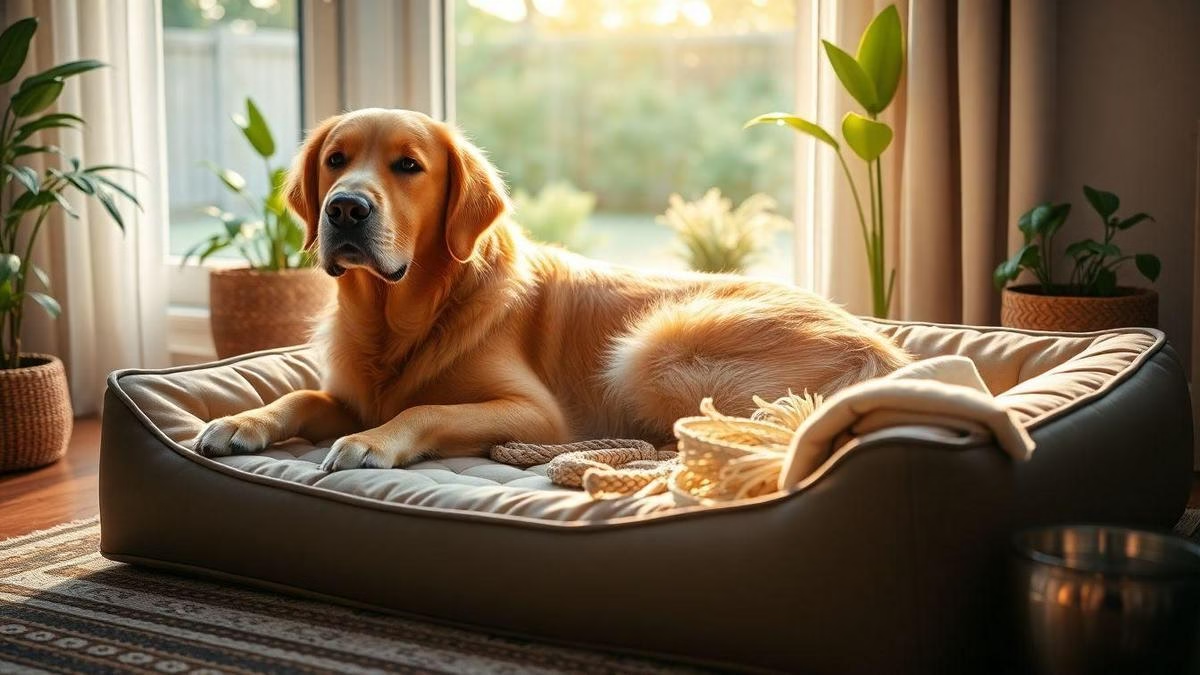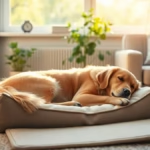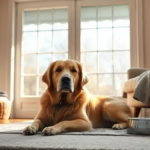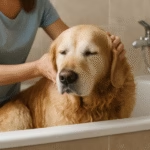Daily Routines That Senior Golden Retrievers Appreciate — I wrote this to share how I start the day with my slightly bossy, mostly sleepy golden who actually enjoys the routine. I keep morning care calm with a gentle bathroom and potty schedule, soft grooming, and meds done like a pro. I do a quick joint check and a light massage. My feeding plan uses strict portion control, split meals for easy digestion, and timing that helps with potty breaks. We stick to short low impact walks, swims when the vet says yes, and always warm up and cool down. I favor soft play, limited stairs, simple stretches, and brain games like puzzle feeders and scent hunts. I watch for any signs to stop and call the vet. I also set quiet nap times and a cozy evening routine with a last potty, dim lights, and a tiny nighttime checklist so we both sleep better.
If you’re building a dependable rhythm, a good starting place is a guide to creating a healthy routine for senior Golden Retrievers — it helped me shape the habits below.
Key Takeaway
- Short, slow walks so my golden still wags at the end.
- Soft food and joint-friendly treats to help movement.
- A low, cozy bed and warm spot so my dog naps like royalty.
- Gentle games and simple tricks to keep his brain sharp.
- Regular vet checkups and easy grooming to catch problems early.
How I start the day with a morning care routine senior golden retriever actually enjoys
I wake up to a warm nose and a silent demand for breakfast. My old golden moves slower than he used to, so I move slower too. I begin with soft talk and a steady hand, letting him sniff the world awake. That tiny ritual sets the tone and keeps us on the kind of Daily Routines That Senior Golden Retrievers Appreciate.
Next I handle basics: a short leash walk, a bathroom stop, and a little stretch session that feels more like a polite negotiation than a workout. I keep the pace calm and expect frequent pauses for sniffing. He gets praise, a small treat if he’s steady, and a gentle rub behind the ears. These three small acts turn morning chores into a pleasant exchange, not a checklist.
Finally, breakfast is served in a quiet spot with fresh water warmed slightly on cold days. I time meds or supplements right after he eats so it becomes part of the flow. The whole routine is short, predictable, and low drama—his three favorite things. For food choices and portion ideas I referred to a complete guide on proper nutrition for Golden Retrievers over 7.
My simple bathroom and potty schedule for senior dogs each morning
I take him out within 10 minutes of waking. Seniors can’t hold it all night, and letting him go first helps avoid accidents. We use the same spot if possible—familiar smells speed things up. If he’s stiff, I give him a minute to circle and sniff; forcing movement is a bad idea.
When he’s done I praise him gently and offer a tiny treat. I also watch for changes—more frequent peeing, straining, or accidents can mean a vet visit. To keep mornings predictable, I stick to a simple step-by-step routine:
- Wake, greet, calm voice.
- Short leash walk to usual spot (5–10 minutes).
- Wait patiently, allow full sniff time.
- Praise and tiny treat, then water and rest.
If you notice new or sudden changes in toileting, resources on signs of pain and essential veterinary care can help decide when to call the vet.
Morning care routine: gentle grooming, meds, and a short stretch
After potty and breakfast I groom him for five to ten minutes. A soft brush removes loose fur and feels like a spa for a dog who remembers chasing every ball. I check ears for wax and smell, glance at his teeth, and wipe his face if needed — I follow gentle grooming tips for senior Goldens and general coat and skin care advice.
Meds and supplements come next. I hide pills in a favorite treat or use a soft chew, then we do a short stretch routine: slow sit-to-stand reps and gentle hip flexes. Nothing aggressive—just a few movements to keep joints moving and blood flowing. I keep it playful, with rewards and a goofy voice so he thinks he’s playing a game. For supplement choices I cross-checked recommendations in a piece on natural supplements for senior Goldens.
| Item | Purpose | Morning timing |
|---|---|---|
| Joint supplement (vet-recommended) | Support mobility | With breakfast |
| Omega-3 / fish oil | Coat and inflammation support | With food |
| Prescription pain med (if prescribed) | Manage chronic pain | As directed by vet |
Quick joint check and gentle massage
I run my hands along his hips, knees, and shoulders, feeling for warmth or swelling and watching his face for discomfort. Then I do a short circular massage with soft pressure, ending at the shoulders where he loves it most. The goal is to reassure him and spot changes early—massages calm him and keep my fingers trained to notice anything off. For techniques I picked up useful pointers from an overview of therapeutic massage basics and combined them with advice on comforting a Golden with arthritis.
The feeding schedule I follow (part of Daily Routines That Senior Golden Retrievers Appreciate)
I found a rhythm that works for my old golden, Buddy, and it changed our days for the better. Buddy gets two main meals, a small snack midday, and water on demand—nothing dramatic, just a steady drumbeat he can trust.
I watch how he moves after eating. If he’s sluggish or has gas, I tweak the food or the timing. I switched to a senior formula with more fiber and joint support and moved to measured portions. That cut his midnight fridge raids to zero. For meal ideas and whether to go natural or commercial, I compared tips in natural diet vs commercial food and a guide on creating appetizing meals for senior Goldens.
Keeping the same times every day helps his digestion and bladder. He knows when breakfast and dinner come, so bathroom breaks line up better. That predictability means fewer accidents and less frantic dashing outside at 3 a.m.
Portion control, senior dog food, and splitting meals to help digestion
I measure every meal. A kitchen scale became my best friend when Buddy started slowing down. Senior formulas often have fewer calories and more fiber, which helps weight and stools. I also add a splash of warm water to dry kibble sometimes—Buddy thinks it’s a gravy upgrade and it softens the kibble for easier chewing.
Splitting meals works wonders. I give half the breakfast when he first wakes and the rest an hour later if he seems hungry. Smaller meals mean less bloating and fewer digestive surprises. For treats, I use kibble as rewards so calories don’t sneak up on us. For practical tips on keeping weight steady, I used a plan from maintaining ideal weight.
- Weigh the full daily amount, divide into meals, and stash portions in the fridge or marked containers.
Feeding timing to support bathroom and potty schedule
I feed Buddy at 7 a.m. and 6 p.m. Most mornings he needs a bathroom break within 20–30 minutes of eating. That window is golden. Evening timing matters more as he ages. I pull water down an hour before bed and take him out right after his last small snack. If your golden has a tiny bladder, add a short late-evening walk rather than a big meal late at night.
| Time | Meal/Action | Purpose |
|---|---|---|
| 7:00 AM | Breakfast (half/whole) | Energy for the morning, potty window |
| 12:00 PM | Small snack (kibble) | Stable blood sugar, treat control |
| 6:00 PM | Dinner | Main evening meal, evening potty prep |
| 10:00 PM | Short potty break | Reduce night accidents |
Measuring food and treats to keep weight steady
I use a kitchen scale for accuracy and a measuring cup for walks and quick snacks. Treats are limited to 5–10% of daily calories; most training rewards are just a few kibble pieces. When Buddy gained a pound after winter, the scale made the cutback obvious and the pound came off in two weeks.
The gentle exercise I do with my buddy: low-impact walks and swims
I learned that my old golden still loves to move but hates drama. So I swapped marathon fetch for gentle motion: short walks and weekly swims. Those keep his tail wagging, hips looser, and my guilt at bay. These are simple Daily Routines That Senior Golden Retrievers Appreciate — consistency, not distance, is the trick. For a roundup of suitable activities I read a helpful piece on safe and beneficial exercises.
I pick the same quiet routes and the same slow pace so he knows what to expect. Predictability calms him and lets me watch for subtle signs: a slower step, a limp, or the give-me-a-break sigh. When he tells me enough, I listen.
I also mix in short mental games: a sniff stop, a hidden treat, or a soft command he enjoys. These tiny rewards make movement feel fun instead of a chore.
Low-impact walks: short routes and slow pace
I walk Charlie twice a day on flat, grassy paths that don’t jolt his joints. Each stroll is short—10 to 20 minutes—and slow enough for him to sniff like a detective. I use a front-clip harness to reduce pressure on his neck and keep our steps relaxed.
- Warm-up sniff (2–3 minutes)
- Gentle walk (10–15 minutes)
- Sniff breaks and slow pace
- Short cool-down and quiet praise
Swimming and hydrotherapy (vet-cleared)
Swimming gave Charlie a second youth without pavement impact. Water supports the body and lets him move with less pain. I always checked with our vet first and started with a slow, shallow intro. A dog life jacket and calm water turned his first swim into a goofy, grateful grin.
For targeted rehab and strength work, hydrotherapy and canine physical therapy helped us progress safely.
Warm-up, slow walk, and cooldown to protect joints
Begin every session with easy sniffing and slow walking to warm his muscles, keep the main walk languid and steady, and finish with gentle massage and a short sit to cool down. Small touches—a paw rub, a slow pet—help circulation and reduce soreness.
Joint-friendly activities I recommend from experience
Long runs and high jumps stop being fun and start causing limps. I swapped marathon games for gentle routines that keep him happy, loose, and still goofy. My approach mixes calm play, short practiced walks, and cozy recovery time—what I call the “slow and steady tail wag” plan. Daily Routines That Senior Golden Retrievers Appreciate fit snugly into this: short predictable sessions, tasty rewards, and plenty of naps.
I keep activities short and consistent. That repetition builds confidence and helps me spot small changes fast.
Soft play, controlled fetch, and limited stairs
Soft play means plush toys, low-energy tug, and games that don’t launch him into orbit. I trade rubber balls for plush discs. Controlled fetch: toss the toy a few feet, sit on the porch, and call it a victory when he returns. If we’re inside, I roll the toy along the floor so he slides instead of leaps.
- Start with 2–3 minute fetch intervals.
- Use soft toys and smooth surfaces.
- Pause if he breathes hard, slows, or seems hesitant.
- Avoid stairs and jumping on/off furniture after play.
To make the home easier to navigate for an aging dog I followed tips on adapting the home for senior Goldens and picked a low, supportive mattress after reading a guide on choosing the perfect bed.
Simple stretches and light massages to ease stiffness
I learned gentle stretches in a vet class and adapted them to our couch. I never force a stretch: I coax. For example, I gently lift a paw and extend it a little, then stop and praise. Light massages became our evening ritual—five minutes usually does it.
| Stretch / Massage | What I do | Duration | Caution |
|---|---|---|---|
| Hind-leg stretch | Gently extend one back leg while he lies down | 10–15 sec each leg | Stop if he resists or yelps |
| Shoulder rub | Slow circular rub near shoulder blade | 1–2 minutes each side | Avoid hard pressure on tender spots |
| Spine sweep | Light long strokes from neck to tail | 30–60 seconds | Watch for discomfort or stiffness increase |
For deeper help, resources on physical therapy and specific advice for comforting arthritic dogs were useful references.
Signs I watch to pause activity and call the vet
If he starts limping, holds a paw up, breathes heavily after a short walk, has sudden swelling, or cries when touched, I stop immediately and call the vet. Also watch for loss of appetite, lethargy beyond a normal nap, or trouble rising. For more on red flags and what to look for, see identifying the first signs of aging and signs of pain.
Mental stimulation: games I use to keep him happy and sharp
I treat his brain like a garden that still needs watering. Otis naps like a pro, but give him a sniff puzzle and he perks up. Short, tasty games break the day into small adventures. I stick to gentle challenges that respect his joints and energy: scent work, slow food puzzles, and soft tug toys.
Consistency helps. I follow Daily Routines That Senior Golden Retrievers Appreciate: a quiet walk, a sniff session, a puzzle after meals, then a calm chew. When he solves a snuffle mat or finds a hidden treat, his tail does the slow-wag-of-approval thing. For more game ideas see mental enrichment activities and keeping the senior mind active.
I pick games that are simple to change up. If a puzzle gets too easy, I hide the treat deeper or swap scents. Watch for frustration—too much pawing, repeated failures, or panting—and scale back.
| Game | How I play | Best for | Time per round |
|---|---|---|---|
| Snuffle mat | Sprinkle kibble in layers of fabric | Nose work, slow eating | 5–10 min |
| Muffin tin balls | Put treats in cups, cover with balls | Problem solving | 3–7 min |
| Hide-and-seek scent trail | Drag treat along floor, hide end | Tracking, confidence | 5–10 min |
| Puzzle feeder | Food releases with nose/paw | Slow feeding, focus | 10–20 min |
- Quick checklist: rotate games daily, keep sessions short, change treats, and watch body language.
Puzzle feeders and scent games I hide around the house
Puzzle feeders are my secret weapon. Otis eats more slowly and I get peace while he works. I use simple feeders—soft plastic puzzles, treat balls, and snuffle mats. Scent games are even better: hide treats under cups, between pillows, or in a rolled towel. Keep trails short and obvious at first.
Short training and memory exercises
I teach a few tricks in five-minute bursts: name recognition, “touch,” and “find it.” One simple routine: ask for a sit, give one treat, then ask for touch twice. Memory games—hide a toy under a blanket—are fun and light. The goal is to keep his brain lit, not fried.
Rotating toys and challenges so he doesn’t get bored
I rotate toys like a DJ swaps records: chew toy Monday, snuffle mat Tuesday, soft tug Wednesday. Swap one toy from each category weekly. New textures and small challenges spark interest without overdoing it.
How I set a rest and nap schedule plus an evening calming routine
Buddy needs routine like I need my morning coffee—predictable and life-saving. I set three main nap windows: mid-morning, early afternoon, and late afternoon. Short, regular rests—20 to 45 minutes—keep joints and brain refreshed without long stiff recoveries.
Building the schedule took trial and error. I watch his energy and adjust. If he’s restless at night, I move a nap earlier. If he’s stiff in the morning, I add a gentle stroll before breakfast. The schedule is a living thing. For ideas on sleep timing and ideal bedding, I used an ideal sleep routine guide and a post about choosing the perfect bed.
I call this set of habits “Daily Routines That Senior Golden Retrievers Appreciate”—it’s the whole rhythm: light exercise, short naps, consistent meal times, and calm evenings. That rhythm reduced his night pacing and cut down sudden potty trips.
| Time of day | What I do | Why it helps |
|---|---|---|
| 8:30 AM | Short leash walk breakfast | Eases stiffness, sets the day |
| 11:00 AM | 20–30 min quiet nap | Rest for joints and brain |
| 3:00 PM | Gentle play or sniff time nap | Mental stimulation without strain |
| 7:00 PM | Light dinner, last bathroom, dim lights | Prepares for a smooth night |
Quiet naps, consistent rest times, and a soft bed
I pick a spot by the window where sunlight hits in the morning and keep a soft orthopedic bed there. The bed is low to the ground so he can hop or shuffle in without twisting his hips. Soft support means less pressure on creaky knees.
I guard nap times—no loud vacuuming, no sudden music. Consistency trains his internal clock. He now settles almost on cue.
Evening calming routine: last bathroom, gentle petting, and dim lights
Our evening routine is short: a calm walk to the yard, a deliberate last bathroom, then slow petting and low lights. The walk is about sniffing and balance, not miles. Dim lights and gentle petting help his heart rate drop. This simple pattern cuts his nighttime pacing and reduces surprise wake-ups.
Nighttime checklist for comfort and a smooth bathroom and potty schedule
I keep a short checklist on the fridge so guests don’t improvise his routine:
- Evening walk and last bathroom (20 minutes)
- Water pulled 1 hour before bed (unless vet says otherwise) — also check signs of dehydration if fluid needs change
- Soft bed in favorite spot, blanket folded
- Dim lights and quiet music or white noise
- Quick joint massage and teeth check if needed
Why these Daily Routines That Senior Golden Retrievers Appreciate work
These routines work because they combine predictability, physical care, and mental stimulation. Senior Goldens often thrive on a steady rhythm—regular meals, predictable potty windows, gentle movement, and quiet downtime reduce stress and help the body cope with age-related changes. Small, consistent habits add up: measured food keeps weight steady, short walks preserve mobility, and short mental games keep cognition engaged.
Most importantly, these Daily Routines That Senior Golden Retrievers Appreciate are adaptable. Pay attention to your dog’s signals, tweak timing or intensity, and prioritize comfort over performance. The goal is a calmer, happier dog and fewer surprises for you. If you want a full checklist of simple daily steps, see simple daily care routines for senior Goldens and daily comfort routines.
Conclusion
What senior Goldens really want is routine and a life with less drama and more naps. I keep mornings calm, meals measured, and walks short and slow. I do quick grooming, a hands-on joint check, and gentle massage—little rituals that say, I’ve got you, without turning the day into a circus.
Predictable potty timing, split meals for easy digestion, and a soft orthopedic bed make days smoother and nights quieter. I trade marathon fetch for low-impact walks, vet-approved swims, and brain games like puzzle feeders and scent trails. That combo keeps his tail wagging and his mind sharp.
I watch for red flags—limping, sudden swelling, loss of appetite—and call the vet if anything blinks like a dashboard alarm. For more about when to involve your vet, refer to essential veterinary care and guidance on recognizing pain. That vigilance, plus small daily comforts, buys us better mornings, calmer afternoons, and peaceful nights. It’s less about heroic fixes and more about tiny, steady kindnesses.
If you liked these tips from my daily playbook, wander over and read more at https://topcuriosities.com. Your senior golden (and your tired shoes) will thank you.

Rafael Souza is a digital marketing strategist and lifelong dog enthusiast. Passionate about Golden Retrievers, he shares practical, research-based tips to help owners provide healthier and happier lives for their furry companions.





